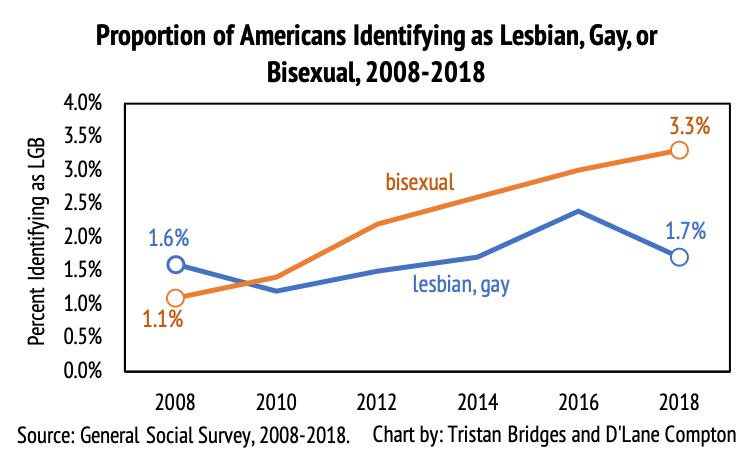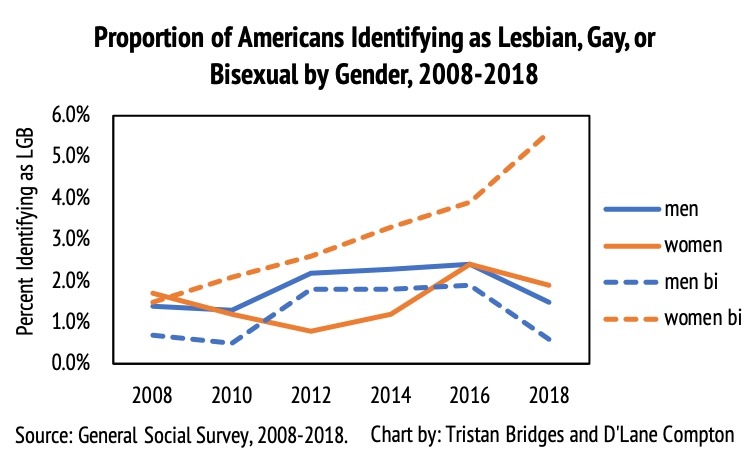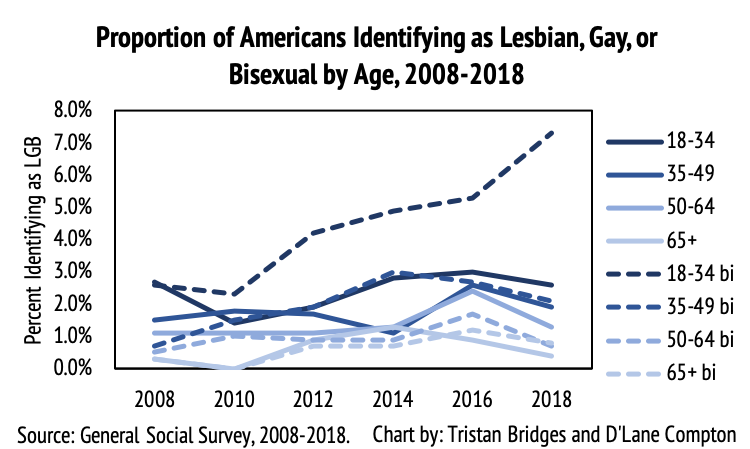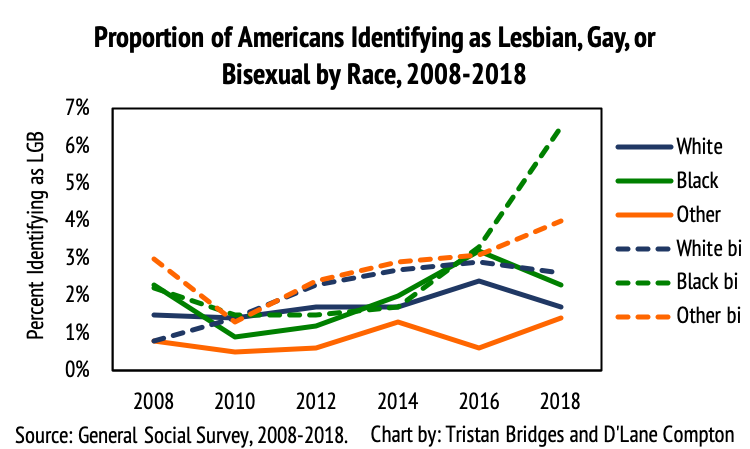The 2018 General Social Survey data was just recently publicly released. We were eager to see how things shifted, especially for the demographic questions on sexual identity. As of 2018, it has officially been one decade that GSS has been asking respondents to characterize their sexual identity on the survey, you can self-classify as “heterosexual or straight,” “gay,” “lesbian,” “homosexual,” “bisexual,” or “don’t know.” This is only one way to measure sexual identity among many, but the growth in LGB identity has been generally comparable across instruments in the past.
As Tristan has noted before, reporting on shifts in the LGBT population treats the group as homogenous and artificially presents growth in LGBT identity as though it might be equally distributed among the L’s, G’s, B’s, and T’s. But that’s not true. Bisexual women account for the lion’s share on the growth in LGBT identification. And, as Tristan and Mignon Moore showed in 2016, young Black women account for a disproportionate amount of the growth in LGB identification.
Data from GSS shows an increase in LGB identification between 2008 and 2018. Below, we charted shifts in those identifying as lesbian and gay alongside those identifying as bisexual. Consistent with what Tristan showed in 2016, bisexual identification continues to be increasing at a steeper rate.

In fact, when you look at the proportions identifying as lesbian and gay or bisexual in 2008 and compare those with the proportions identifying as lesbian and gay or bisexual in 2018, lesbian and gay identifications have not really moved much. But bisexual identities continue to increase every year.
This is consistent with other national survey work. For example, using the National Survey of Family Growth (NSFG), Compton, Farris and Chang (2015) found that almost nine percent of women in the sample and about four percent of men in the sample in 2008 and 2002 reported behavior as bisexual; that is, having sex with at least one male and at least one female partner in their lifetime. Rates of self-identification as bisexual were much lower (in 2008 0.43% of women and 0.38% of men). Perhaps with increases in social tolerance people are more likely to claim bisexual identities today, regardless of their participation in the behavior.
Previous work has also suggested that much of the growth in LGB identities is happening among women. The GSS data show that the shift appears to be primarily happening among bisexual women. Indeed, bisexuality continues to be a more popular sexual identity than lesbian among women, but a less popular sexual identity than gay among men, as others have shown. As of 2018, almost 6% of women responding to the survey identified as bisexual compared with 1.5% in 2008. Comparatively, shifts in lesbian identities among women and both gay and bisexual identities among men really haven’t shifted much.

And similar to previous analyses (here, here, and here), this shift is particularly pronounced among the young. The figure below shows changes in lesbian and gay identities alongside shifts in bisexual identities for four separate age cohorts. The real shift in among bisexual identification among 18-34 year-olds. Between 7 and 8% identified as bisexual on the 2018 GSS survey. This is all the more interesting when you look at the 2008 data on these figures. Bisexuality did not stand out in these data in 2008. In fact, in 2008, more people identified as lesbian and gay than bisexual. This shift has emerged and grown in an incredibly short period of time.

As other data have shown as well (see here and here, for instance), people of color account for a disproportionate amount of this shift. Black bisexuals accounted for almost 7% of Black respondents on the 2018 GSS. That’s a big shift as well. And while bisexual and lesbian/gay identities were moving along similar trajectories for Black Americans through 2016, as of 2018, bisexuality was much more common (as has been true for White respondents and those of other races… yes “other race” is actually the category GSS uses… and no, it’s not a good idea).

So what do we do with all of this? One thing that we ought to take from this is to take scholarship on bisexuality more seriously. As a sexual identity, bisexuality is less studied than it ought to be. But bisexuality has continued to grow and continues to represent a larger number of people’s sexual identities than lesbian and gay combined. This is interesting for a number of reasons, but one is that much of the growth in the LGBT community might actually be the result of changes in the population of bisexual identifying people (and this is a group that is disproportionately composed of women). Whether bisexual identifying people understand themselves as a part of a distinct sexual minority, though, is a question that deserves more scholarship. If we are going to continue to group bisexuals with lesbian women and gay men when we report on shifts in LGB populations, this might be something that deserves better understanding and more attention. Context matters in how we understand identities and how they change or evolve over time.
Originally posted at Inequality by Interior Design. Read more and dive into the details there!
D’Lane R. Compton, PhD is an associate professor of sociology at the University of New Orleans with a background in social psychology, methodology, and a little bit of demography, they are usually thinking about food, country roads, stigma, queer nooks and places, sneakers and hipster subcultures. You can follow them on twitter.
Tristan Bridges, PhD is a professor at the University of California, Santa Barbara. He is the co-editor of Exploring Masculinities: Identity, Inequality, Inequality, and Change with C.J. Pascoe and studies gender and sexual identity and inequality. You can follow him on Twitter here. Tristan also blogs regularly at Inequality by (Interior) Design.

Comments 9
Mercella Fiddler — April 17, 2019
Mercella Fiddler
Professor Cook
Social Problem
April 17, 2019
My chosen blog was found in the Society’s Page and address the issue of sexual orientation and conflict theory with special emphasis on bisexuality among females. Sexual orientation refers to the different socially constructed labels that society use to define an individual’s sexual preference as it relates to intimacy between and among the different genders. Currently, the four major sexual orientation are heterosexual, homosexual, bisexual and asexual. In America heterosexual union is the dominant union, with this is mind all other orientation are deemed as minority and a deviation from social norms.
Consequently, individuals that are identified as the “other” are at a risk of discrimination. I found out in this research article that “Bisexual women account for the lion’s share on the growth in LGBT identification (D’Lane Compton and Tristan Bridges, The Bisexual Boom)” in a research conducted by Tristan Bridges and published by the Generals Social Survey Data .This was a startling discovery. However, I believe the fact that the American society is predominantly patriarchal and is more lenient to the flexibility of men sexual patterns and behaviors compared to women, many bisexual female minded women kept their lifestyle in the “closet.” As such women were less open about their sexuality if it was not in line with society’s norm. Additionally, the increase in social tolerance toward a diverse sexually oriented society has brought about some level of comfort among LGBT society with special emphasis on bisexual women. This acceptance can be viewed through the lens of the social conflict theory on sexuality as a construct that create dominant groups that work assiduously to promote their universal views for economic interest. We can agree that there has been a paradigm shift in the power of women, more so women of color. Women are becoming more economically viable. As such women are now given an opportunity to express themselves from a sexually oriented standpoint less discrimination.
Another reason for the rise in bisexuality among women can be viewed from a man’s perspective. In a bid to prove masculinity men are willing to accept their partner with a woman opposed to another man. I can relate to this, I have a dear friend that has been married for years I realize that she is also a bisexual, what was dumbfounding about my discovery is that her husband knew and was comfortable with the union. Some critics argue that again, it is the perceived male dominance and male ego that cause men to accept their partners having extra-marital relationships with other women. It is also arguable that these men benefit from these relationships because the sometimes engage in the sexual and this may give them some feeling of power.
Another startling yet understanding discovery from the article is that “young Black women account for a disproportionate amount of the growth in LGB identification (D’Lane Compton and Tristan Bridges, The Bisexual Boom).” This is not unbelievable and is justifiable on two levels. First, being a woman, you are automatically inferior by society’s standard. To make matters worse being a black woman puts an individual at a greater risk of being discriminated against, because you fall into the minority population of the society. Let’s put both biases together, being black and being a woman, would it be fitting to be identified as a bisexual ten years ago? I say no, this would only add insult to injury. However, with the rise in the LGBT movement globally advocating for understanding and support towards sexual diversity and of course, taking the social conflict theory in account black women feel freer to express their sexuality at with little fear of discrimination. I use “little” loosely because though there has being positive strides in acceptance of sexual diversity, there is still a long way to go towards gaining equality. Bisexuality among women in hindsight does not disprove society’s construct of the dominance of a heterosexual society but allows women to exercise freedom of sexual choices with less discrimination.
Work Cited
D’Lane Compton and Tristan Bridges, The Bisexual Boom, April 16 , 2019, https://thesocietypages.org/socimages/2019/04/16/the-bisexual-boom/ April 17, 2019.
Meowessay — April 24, 2019
I'm a professional essayist myself and I can state that it is an excellent work! Everything's just in it's right place, very soft and interesting narration. Will come back to read more for sure! Cheers, Elvis.
coca — February 24, 2020
Information about The explosion of bisexual people you share is quite interesting, with lots of good information, I'm very interested.
fnaf world
MichellePSisk — June 27, 2021
私もわかりませんでした。答えが得られたらなぜ起こったのか知りたかったので教えてください。さて、皆さんは 日本円 オンラインカジノについて知っていますか?そうでない場合は 詳細はこちら 。私はこの問題の解決策をすぐに見つけることを願っています。
totoguy — December 5, 2022
I would like to compliment you for your expert opinion on the subject you have written. How can you understand it so easily? Also, how good the quality of information is. I know your efforts to write this article better than anyone else. Thank you for sharing a good message. 메이저사이트
totoright — December 5, 2022
I also benefit from learning to evaluate, but I learn that many people have to stay in their essays to add value in the direction of true weblog presentation. 먹튀사이트
Alex Hopkins — February 15, 2023
Positive site, where did you come up with the information on this posting? I have read a few of the articles on your website now, and I like your style. Thanks a million and please keep up the effective work stumble guys
Nanisa — October 3, 2023
bitlife is a life simulation game with fake yet accurate obstacles. You will control a life from infancy to old age if you play the game. This implies that you must choose the best course of action for your life since your choice will influence how joyful your life will be bitlife online
Civaget — April 13, 2024
오피스타 offers a wide range of massage services. The user reviews are valuable for making informed decisions. Highly recommend!